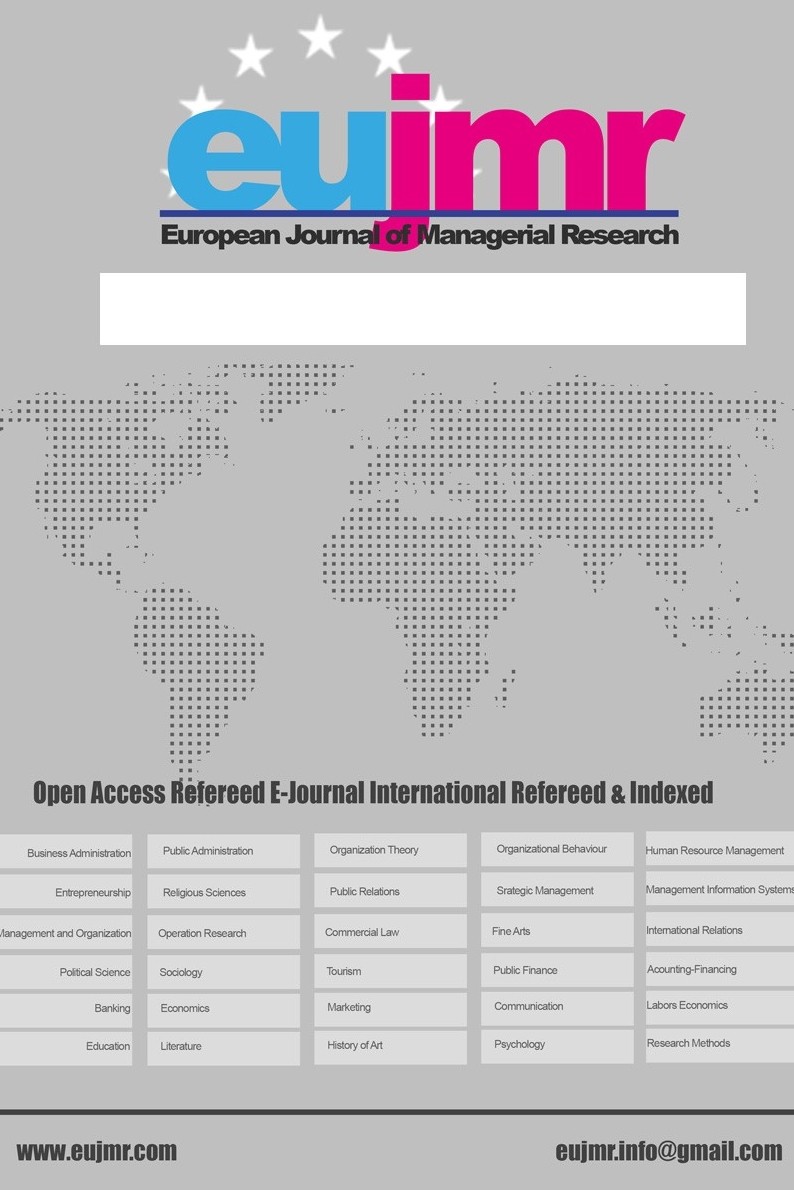Yeşil Ekonomi Girişimciliği İçin İnovasyon Stratejisi Olarak Biyomimikri
Yeşil ekonomi, biyomimikri, inovasyon, yenilik, girişimcilik, doğa
Biomimicry: An Innovation Strategy for Green Economy Entrepreneurship
Green economy, biomimicry, innovation, nature, entreprenurship,
___
- Akkaya, B., & Yazici, A. M. (2020). Comparing Agile Leadership With Biomimicry-based Gray Wolf: Proposing A New Model. Business & Management Studies: An International Journal, 8(2), 1455-1478.
- Benyus, J. (2002). Biomimicry: innovation ınspired by nature. New York: Perennial.
- Chiu, W. T., & Tseng, S. C. (2015, July). The influence of bionic creatures and natural condition on design inspirtation. In 2015 IIAI 4th International Congress on Advanced Applied Informatics (pp. 713-714). IEEE.
- Debolini, F. (2006). Art Book Leonardo da Vinci. Ankara: Dost Kitabevi Yayınları, p.92-93
- Dicks, H. (2016). The philosophy of biomimicry. Philosophy & Technology, 29(3), 223-243.
- Georgeson, L., & Maslin, M. (2019). Estimating the scale of the US green economy within the global context. Palgrave Communications, 5(1), 1-12.
- Feigenberg, J. M. (2014). Nikolai Bernstein From Reflexes to the Model of the Future. Studies in Sports History. (Vol. 17). LIT Verlag Münster, s.vii
- Güss, C. D., Ahmed, S., & Dörner, D. (2021). From da Vinci’s Flying Machines to a Theory of the Creative Process. Perspectives on Psychological Science, 1745691620966790.
- Hargroves, K., & Smith, M. H. (2006). Innovation inspired by nature Biomimicry. Ecos, (129), 27-30.
- Huo, L. K., Abdul-Rahman, H., Wang, C., & Siaw-Chuing, L. (2017). Bee inspired route management approach and use of internet of things. The Journal of Modern Project Management, 5(2).
- Ki-Moon, B. (2013). The millennium development goals report 2013. United Nations Pubns, 365, 366. https://www.un.org/millenniumgoals/pdf/report-2013/mdg-report2013_pr_global-english.pdf Access: 15.6.22
- Moore, J. F. (1993). Predators and prey: a new ecology of competition. Harvard business review, 71(3), 75-86.
- Myjer, E. P., & White, N. D. (2002). The Twin Towers Attack: An Unlimited Right to Self‐Defence?. Journal of Conflict and Security Law, 7(1), 5-17.
- OECD (2017), Green Growth Indicators 2017, OECD Green Growth Studies, OECD Publishing, Paris, https://doi.org/10.1787/9789264268586-en. Access: 12.6.22
- Orman, B. (2013). Art Nouveau & Gaudí: The Way of Nature. JCCC Honors Journal, 4(1), 2.
- Pearce, D., Markandya, A., & Barbier, E. (2013). Blueprint 1: for a green economy. Routledge.
- Plotkin, M., Hod, I., Zaban, A., Boden, S. A., Bagnall, D. M., Galushko, D., & Bergman, D. J. (2010). Solar energy harvesting in the epicuticle of the oriental hornet (Vespa orientalis). Naturwissenschaften, 97(12), 1067-1076.
- Richardson, J. (2005), "Leonardo: why the inventor failed to innovate", Foresight, Vol. 7 No. 5, pp. 56-62. https://doi.org/10.1108/14636680510623379 Access: 20.5.22
- Schwartz, S. H. (2012). An overview of the Schwartz theory of basic values. Online readings in Psychology and Culture, 2(1), 2307-0919.
- Shukor, S. F. A. Avian-Centric Design. Nature’s Yield and Wonders of Art (NYAWA) 15, p.81 https://core.ac.uk/download/pdf/153825146.pdf Access: 14.6.22
- Stecker, T. (2011). Artificial Leaf Might Provide Easy, Mobile Energy. Scientific American. https://www.scientificamerican.com/article/artificial-leaf-might-provide-mobile-energy/ Erişim: 16.5.22
- United Nations Environment Management Group (UNEMG). (2011). Working towards a Balanced and Inclusive Green Economy: A United Nations System-Wide Perspective. https://sustainabledevelopment.un.org/ Access: 12.6.22
- United Nations (UN). (2022). The Sustainable Development Goals Report. https://unstats.un.org/sdgs/report/2022/The-Sustainable-Development-Goals-Report-2022.pdf, Access: 1.6.22
- Vierra, S. (2011). Biomimicry: designing to model nature. Whole Building Design Guide, 1-10.
- Yang, C. M., Hung, J. Y., Wang, Y. L., & Lien, Y. H. (2019) Analysis of Mercedes-Benz Concept Car Using Biomimicry Design Spiral and Template Analysis–An Exploratory Study, International Journal of Innovation in Management, Vol.7, No.2, p. 49-56
- Yayın Aralığı: Yılda 2 Sayı
- Başlangıç: 2017
- Yayıncı: Himmet KARADAL
Çalışma Yaşamında Değişen Kariyer Anlayışı: Kaleydoskop Kariyer Modeli
Yeşil Ekonomi Girişimciliği İçin İnovasyon Stratejisi Olarak Biyomimikri
Gökhan BAK, Yunus Emre ÖZDEMİR, Alparslan BAK, Nurettin ATAŞ, İsmail GÜNDÜZ, Esen BİLGİLİ
Merve Kadriye YURDABAK, Recep Baki DENİZ
SİVİL HAVACILIK KABİN HİZMETLERİ ÖĞRENCİLERİNİN YETKİNLİKLERİNİN GELİŞTİRİLMESİNDE YARATICI DRAMA
